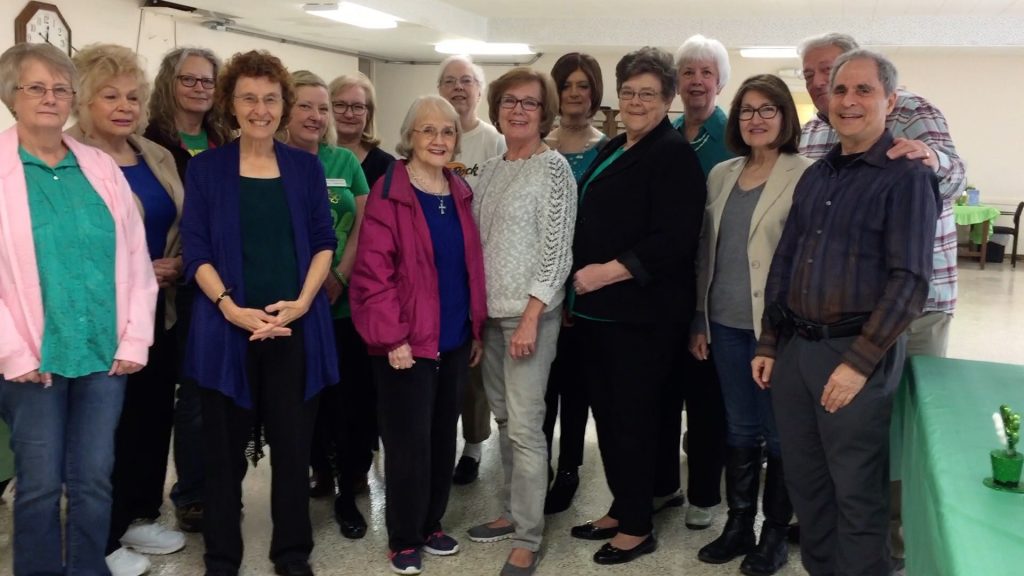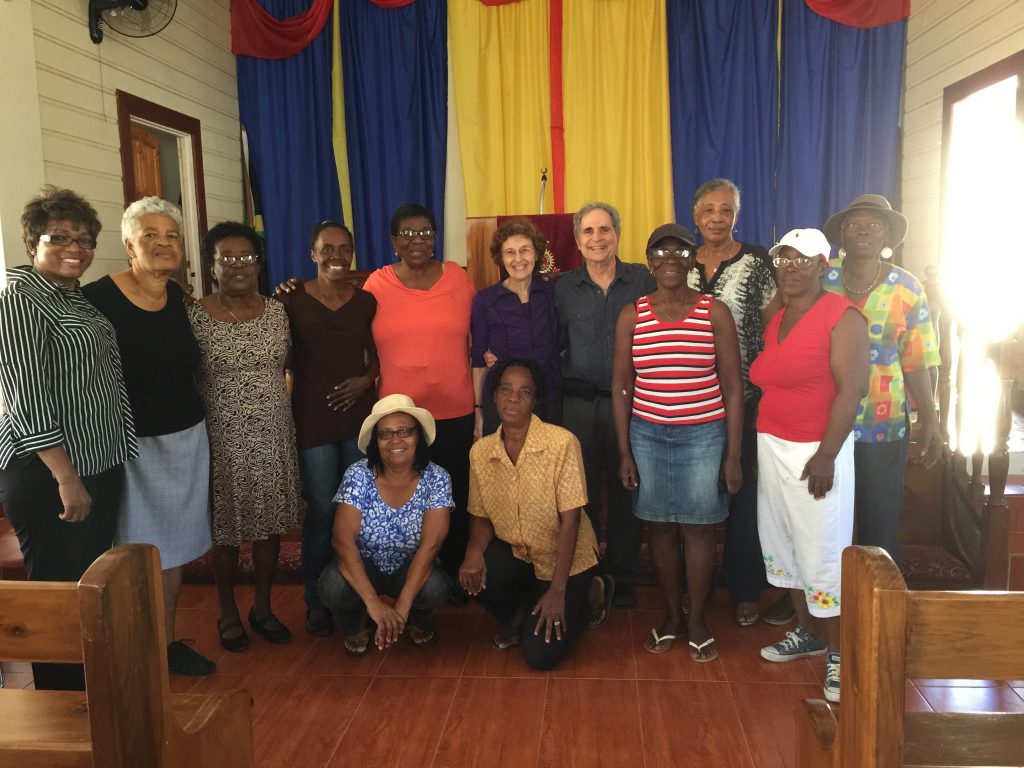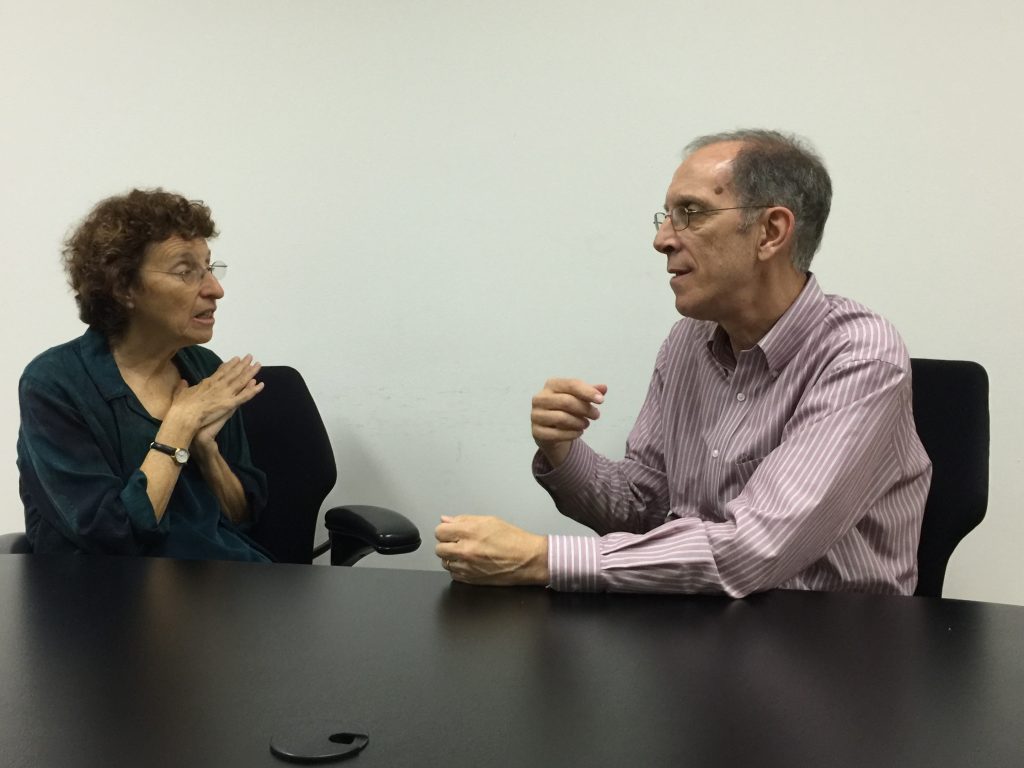Posts Tagged ‘Alzheimer’s Caregiving’
Sharing Ideas for Staying Connected
“How do we stay connected during the dementia journey?” This is a question with dozens of creative answers. Recently, we spent time at Northland Shepherd Center, hosted by Dianna Englander. We were sharing ideas for staying connected with the Together We Care Caregiver Support Group, a lovely gathering of family caregivers and friends. 
Caregiving is such a creative practice, demanding flexibility, humor, and the willingness to make mistakes and try again. We discussed ideas from Connecting in the Land of Dementia, including incorporating singing, laughter, and art into everyday life. We also explored the power of nature and talked about unique concepts for bringing the outdoors inside. We brainstormed different ways we could prepare food together and connect in the kitchen.
Here are some extra ideas we learned from our audience. I’ve changed the names to protect people’s privacy.
Anne’s father, who was normally very active, became very upset when his care facility had to temporarily curtail his movements, due to a flu outbreak.
“I want to go to the hospital,” he told the care staff repeatedly. Finally, they called Anne and asked her to come over.
“Dad was just wild,” she told us. “So I asked him to take a deep breath with me, and told him we were going to watch a basketball game before we problem-solved.” They watched an hour of basketball, which soothed both of them.
“I want to go to the hospital,” her father said.
“Why?” she asked.
“So I won’t feel alone,” he said. “I’m scared to be alone.”
Anne realized how social her father was, always walking down the hallways, greeting people, spending time visiting. She instantly began to problem solve, getting permission to walk down the corridors, wearing protective masks, gathering phone numbers of her father’s friends at the home, so he could call them.
“Taking a break and doing something soothing first really helped us figure out the problem and then solve it,” she said.
…………………….
Before her dementia advanced, Sandra’s friend loved singing in the church choir. Now, when Sandra visits her, her friend frequently asked the same question over and over. Sandra turns to beloved hymns they both know so well and when her friend becomes anxious, starts singing to change the energy. Soon, they are both singing, as they have for so many years, the old hymns guiding them back to a deep connection.
…………………….
Patriotic songs inspired Alvin’s father, Fred. So often, Fred literally tuned out the singers who came to entertain at his memory care community. One day, the group began singing “The Star Spangled Banner,” Instantly, Fred stood and put his hand over his heart. He sang along and kept standing and singing through all the familiar patriotic melodies. Afterwards, he talked about his time in the service, breaking his usual stoic silence.
At the end, we all felt a sense of renewal and companionship. Sharing these important creative ideas had enriched our lives and inspired us anew.
I’d love to hear your ideas for staying connected. Please email me at myinfo@pobox.com.
For more information about the Northland Shepherd Center, visit http://northlandsc.org/about-nsc.html
Deborah Shouse is the author of Connecting in the Land of Dementia: Creative Activities to Explore Together and Love in the Land of Dementia: Finding Hope in the Caregiver’s Journey.
Finding Meaningful Memory Care
“I feel like I’ve been on extended vacation,” Ron’s father Frank said, after his first day in a memory care facility. “Today was really enjoyable.” Ron and I just melted with happiness. We had visited many facilities, with the hope of finding meaningful memory care with great activities. Frank couldn’t have said anything nicer.
It’s quite an emotional journey, finding meaningful memory care. I asked my friend, Dr. El, Dr. Eleanor Feldman Barbera, PhD, author of The Savvy Resident’s Guide and a columnist for McKnight’s Long Term Care News, for some tips.
Finding Meaningful Memory Care With Engaging Activities
“Remember, everything is an activity,” says Dr. El. She encourages care partners to seek a community with a dedicated memory care program, so people with cognitive impairments can benefit from all the offered activities.
“In a specialized unit, staff are trained to work with people who are living with dementia,” Dr. El says. “This training can help people enjoy greater independence.”
In one facility, a lady liked to wander into people’s rooms and take their jewelry. Rather than getting upset, the staff understood, framed this as “shopping,” and simply returned the jewelry.
“These kinds of insights create a calmer, slower-paced environment that reduces agitation,” says Dr. El.
Seek Structure, Soothing and Variety
Here are some things to look for, as you visit facilities:
- Is there a home-like atmosphere?
- Is there a structure to the day?
- Are there calming activities scheduled for change of shift? Changing shift is disruptive, so some communities orchestrate a teatime with music or other soothing activities.
You’re also making sure there are a variety of activities throughout the day. These should include:
Outdoor Time: Taking people outside makes a big difference in mood, appetite, and the sense of connection to the world.
Movement: Exercise is an important component to health.
Nurturing: Look for activities that make people feel confident and good about themselves, such as spa days or activities that incorporate skills such as cooking, art or gardening, modified to provide a “success” experience.
Engagement: Being engaged, rather than just entertained, inspires a sense of purpose, creativity, and social connection.
Kindness is Everything
“Meet with the recreational therapist,” Dr. El suggests. “Is she compassionate and caring? Are the staff members kind? You can have all the activities in the world but if they’re not done with gentleness and humanity, they won’t work.”
Let the recreation director know what your loved one likes to do and see if she can adapt the activity.
Stay Involved
Visit as often as you can and attend activities together. Encourage friends and relatives to join you. Meet other residents and get to know the families and staff.
“You can act as a connector to create friendships, so residents engage in their own interaction, even when you aren’t there,” Dr. El says.
For more information, visit Dr. Eleanor Feldman Barbera, PhD, http://www.eldercarewithdrel.com,
Treat yourself to Dr. El’s book, The Savvy Resident’s Guide
Insider’s Tips for Analyzing Activities Programs
My mother had been an artist in her later years, but she stopped painting when she began living with memory loss. Instead, she took comfort in listening to music and in nurturing a baby doll. Ron’s dad studied architecture as a young man, but never had the leisure time to pursue drawing or art. When he moved into a memory care community, he flourished in the Memories in the Making painting program. We worked hard to find care homes that nurtured our parents and my background in healthcare helped us develop a few insider’s tips for analyzing activities programs.
“Families need to share information about favorite hobbies and they also need to be ready for their loved one to try new things and possibly change interests,” says Alisa Tagg, President of the National Association of Activity Professionals. Alisa has helped dozens of facilities build meaningful activity programs.
Here’s an example of how one woman thrived on learning a new skill and giving back:
Mary’s family was amazed when she got involved in a jewelry-making class in the memory care unit. Mary had never thought of making jewelry and she never even wore necklaces, bracelets, or earrings. But she loved beading and was thrilled to share her creative designs with others. Producing something beautiful for others motivated Mary. The facility helped her sell her jewelry and she contributed the money to the activities budget and also donated to charity.
Alisa knows how emotionally challenging it is for families to find good care facilities for their loved ones. Here are some of her insider’s tips for analyzing activities program.
See For Yourself
“You have to view what is going on in the activity room,” she says. “See how the staff interacts with the residents. If there’s an entertainer, is the staff in the back of the room, charting and talking? Or are they in the front, dancing, and singing and engaging with residents and families?”
Look at the activities calendar. Visit the facility at different times and on various days and see if the activities in progress match the scheduled events.
Encourage Engagement
Study the schedule to see how often the residents are engaged, rather than just being entertained. Are they invited to contribute to community service projects? Are they going to sing-alongs or helping with baking projects? People with memory deficits need a variety of activities. Look for a variety of programming that balances the four areas of wellness—spiritual, mental, physical, and emotional.
Visit Programs of Interest
Visit the programs you think your loved one might enjoy.
Find out how many staff members assist in the activities program.
Does the care staff seem aware of the importance of activities? Is there one-on-one assistance for those who want to participate and need extra attention?
Watch for Independent Projects
Is there a place for puzzles, games, cards, and other things people can enjoy independently? Are there opportunities for residents to contribute to their community and to help others around them?
Share Questions and Concerns
“Every facility should have a plan of care meeting, where family can share their expectations and concerns with the nursing staff,” Alisa says. “Ask how your loved one is doing. Share your insights.
A good facility will welcome that meeting.”
Stay Involved
Stay as involved as you can. Helping your loved one connect through meaningful activities may involve trial and error. Get to know the other residents and their families. You’ll stay engaged with your loved one and create a sense of community with a lot of other wonderful people as well. #
To learn more about Alisa Tagg, BA ACC/EDU AC-BC CADDCT CDP and the National Association of Activity Professionals, visit https://naap.info
To delve into creative activities do you can on individual visits, read my latest book, Connecting in the Land of Dementia: Creative Activities to Explore Together.
Build Community Through Sharing Stories.
Just blocks from the bustling tourist shops in the port area of Falmouth Jamaica, stands a white stucco Salvation Army Church. Inside this building, we met with local community leaders. We shared stories and information, offering ways to stay connected throughout the dementia journey. We hoped to build community through sharing stories.
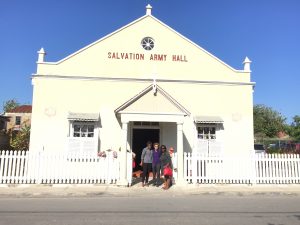
Even before we spoke, Shirley Duncan, a volunteer with Alzheimer’s Jamaica, and one of the event organizers, said, “I have a surprise for you.” She spoke eloquently of the need to talk about dementia, to share experiences, and to be there for the caregivers and people living with dementia. Then she told us that today’s participants were making a commitment to form an on-going group that would educate, advocate, and care for those affected by dementia in their community. “We are calling our group Debron, in honor of you two, because you are the catalysts,” she told us.
Ron had been working with Shirley and Dundeen Ferguson of Alzheimer’s Jamaica for several weeks, setting up the presentation. Shirley and Dahlia Klein orchestrated the details, spreading the word among the community leaders, garnering the venue, and making sure all went smoothly. We were thrilled to be catalysts and delighted to be discussing ideas with such a dedicated group of women, many of whom were former teachers.
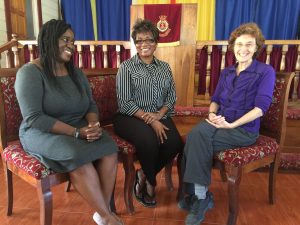 We shared ideas from Dr. Madan Kataria in Mumbai about the power of laughter yoga, and we told a story about creating an inland beach from, Dr. Claire Craig in Sheffield, England. We talked about the power of Dan Cohen’s Music & Memory program and discussed ways to connect through art, citing a story from Teri Miller in Houston, Texas. And we chatted about ways to stay connected through cooking together, sharing our own favorite childhood dishes, which included spiced shrimp, banana porridge, dumplings, roasted corn with shredded coconut, and so much more.
We shared ideas from Dr. Madan Kataria in Mumbai about the power of laughter yoga, and we told a story about creating an inland beach from, Dr. Claire Craig in Sheffield, England. We talked about the power of Dan Cohen’s Music & Memory program and discussed ways to connect through art, citing a story from Teri Miller in Houston, Texas. And we chatted about ways to stay connected through cooking together, sharing our own favorite childhood dishes, which included spiced shrimp, banana porridge, dumplings, roasted corn with shredded coconut, and so much more.
“We will spread these ideas throughout our community,” one of the women told us. “That is what teachers do, we share information.”
We left feeling so inspired and so connected. This is what we all need, caring people, compassionate and eager to learn, ready to offer help and hope.
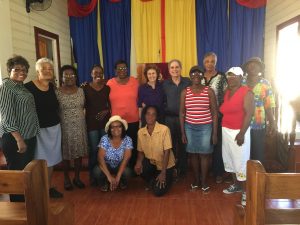
###
During our presentation, we talked about Dr. Madan Kataria’s Ha Ha chorus. At the end, the women said, “We want to sing you a song.” They serenaded us with the Ha Ha chorus. Watch this video and please, sing along.
https://drive.google.com/open?id=0B0elXRV1YrIqUkhqNzN3RkhPSUU
For more about Laughter Yoga, visit Madan Kataria’s website, http://laughteryoga.org
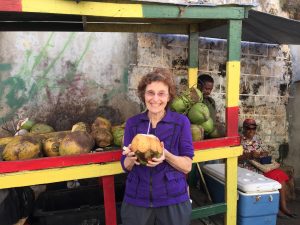
Deborah Shouse is the author of Connecting in the Land of Dementia: Creative Activities to Explore Together and Love in the Land of Dementia: Finding Hope in the Caregiver’s Journey.
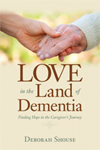

Making a Difference, One Island at a Time
 “We are here to explore meaningful ways to stay connected throughout the dementia journey. We are all going to take what we’ve learned and we need the commitment of all of you to help us reach out to the families living with dementia in our communities,” Raymond Jessurun said when he introduced us at a gathering of healthcare professionals, family caregivers, and government representatives. Raymond, who is Secretary of the St. Maarten Alzheimer’s Foundation, is a passionate and inspiring speaker. He urged everyone to join as volunteers of the Alzheimer’s Foundation to spread the meaningful engagement throughout the island, making a difference, one island at a time.
“We are here to explore meaningful ways to stay connected throughout the dementia journey. We are all going to take what we’ve learned and we need the commitment of all of you to help us reach out to the families living with dementia in our communities,” Raymond Jessurun said when he introduced us at a gathering of healthcare professionals, family caregivers, and government representatives. Raymond, who is Secretary of the St. Maarten Alzheimer’s Foundation, is a passionate and inspiring speaker. He urged everyone to join as volunteers of the Alzheimer’s Foundation to spread the meaningful engagement throughout the island, making a difference, one island at a time.
As a group we discussed many engaging activities, including the joy of singing, the nurturing that animals can offer, the power of looking at art, and the creative conversations that cooking together can inspire. We strategized adding more laughter into the day and the importance of knowing each person’s musical preferences. We were also learned of the challenges family caregivers face, which in residential settings as in the Sint Martin’s Home are being addressed by professional caregivers.
 Our host, Bregje Boetekees, Director of the White and Yellow Cross Care Foundation in St. Maarten, was deeply tuned into the importance of offering an array of individualized activities and to the comfort that nature brings to those who are living with dementia. She is overseeing the construction of a new elderly care facility with a large courtyard that will offer safe and ready outdoor access, as well as fertile ground for gardening and other nature-based activities.
Our host, Bregje Boetekees, Director of the White and Yellow Cross Care Foundation in St. Maarten, was deeply tuned into the importance of offering an array of individualized activities and to the comfort that nature brings to those who are living with dementia. She is overseeing the construction of a new elderly care facility with a large courtyard that will offer safe and ready outdoor access, as well as fertile ground for gardening and other nature-based activities.
As always, we left feeling inspired by each of the people we met. Bregje and her team are constantly exploring ways to enrich the lives of their residents who are living with dementia. Raymond and the board members of the Foundation are an example of how a few compassionate and determined people can make a difference. Just eight years ago, Raymond was struggling to find his mother-in-law the dementia care she needed. His advocacy attracted other caregivers and this year their Foundation, which is recognized by Alzheimer’s Disease International, celebrates its seventh year of serving the community. In June, Raymond is co-coordinating a gathering of leaders of Alzheimer’s organizations of 15 Caribbean countries as a step to forming Alzheimer’s Caribbean. These advocates are making a difference, one caregiver at a time, one facility at a time, one island at a time.
###
We invited everyone to join us in Dr. Madan Kataria’s Ha Ha chorus. Watch this and please, sing and laugh along. Click here to view the St. Maarten HaHa Chorus
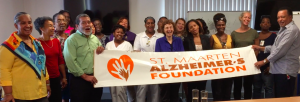
For more about Laughter Yoga, visit Madan Kataria’s website, http://laughteryoga.org
Deborah Shouse is the author of Connecting in the Land of Dementia: Creative Activities to Explore Together and Love in the Land of Dementia: Finding Hope in the Caregiver’s Journey.
Five Ways to Make Valentine’s Day Special for a Loved One with Dementia
My parents liked to celebrate Valentine’s Day with dinner and dancing. Years into my mom’s Alzheimer’s journey, my parents’ love hadn’t diminished, but my mom’s capacity for going out to dinner and dancing had drastically decreased. I saw how blue my father was—one more event he had to give up, one more change in the woman he loved—and I searched for alternatives that might cheer him up. Here are five ways to make Valentine’s Day special.
Look for a favorite thing. Seek one simple pleasure your loved one might enjoy. Mom loved potato soup and chocolate and fresh strawberries. These were part of our celebration.
Nurture yourself: include your own favorite thing. Bring yourself into the celebration and include something that makes you happy. I brought foods my father and I both liked as part of our little party.
Pick several ways to express your love. Poetry, music, gifts, flowers, and photo albums—you can use any of these resources as a catalyst to talk about your feelings. Dad and I sang Mom old show tunes and love songs, music she really enjoyed. Mom adored Shakespeare; we had a couple of sonnets on hand. She and Dad had once created a beautiful flower garden; Dad brought her a single red rose.
Take joy in the simple act of expressing yourself. Being with my mom was a chance to really practice the mythical “unconditional love.” Mom couldn’t tell me she loved me. During one Valentine’s Day celebration, she fell asleep while I was holding her hand and talking sweetly to her. But there was a comfort in expressing my love and I kept on talking.
Celebrate love in all its glorious guises. During their long marriage, my father had walked into a room millions of times and often, Mom had been busy and hadn’t particularly smiled or remarked. But with her dementia came a deep dependency on Dad. When Dad walked into a room, my mother’s face lit up. My father basked in that light. The sparkle in my mother’s eyes was the new, “I love you, darling.” The light said everything my mother could no longer say.
Deborah Shouse is the author of Connecting in the Land of Dementia: Creative Activities to Explore Together and Love in the Land of Dementia: Finding Hope in the Caregiver’s Journey.
Tuning into Music for Connection: Helping Children Accept Dementia
“Oh what a beautiful morning,” I warbled. My mom clapped and hummed along. At the end of the song, she applauded. In her earlier days of motherhood, she might have winced slightly when I wandered off-key. But in the cradle of dementia, she was delighted with my smile, my energy, and the sheer sound of my voice. And I was delighted to be tuning into music for connection.
Carol Bradley Bursack, an author, speaker, family care partner and creator of Minding Our Elders, recently told me the story of how she helped her teenage children stay connected with their grandfather. I loved her ideas and wanted to share her tips with you.
Tuning into Music for Connection
When he was in his 70s, Carol’s father went into surgery to help repair brain damage from a World War II injury. The doctors expected no issues, but during the operation, something went awry. Her beloved father emerged from the procedure deep in dementia, with a constant voice in his head, and no grasp of reality. Valiantly, Carol dealt with her anger and grief while finding a safe and compassionate care community for her father. Then she began searching out ways she and her sons could stay connected with him.
“Dad loved big band music,” Carol says. “I bought every CD I could find. He loved to direct and listen to the music.”
Finding a Musical Bridge
Carol’s sons were very close to their grandfather. He had always been there for them, a vibrant, fun presence, celebrating their abilities, playing chess with them, and listening to their stories. When her sons saw that Grandfather was so changed he couldn’t even hug them and no longer understood the chessboard, they were devastated.
“They didn’t know how to bond with him,” Carol says.
Carol understood their reluctance to visit and gave them some space. She didn’t make the children feel guilty about their feelings, but she did want them to maintain a relationship with their grandfather. Tuning into music for connection came to the rescue.
The boys both played instruments and Carol urged them to take their clarinet and trumpet to the care community. At first, they were hesitant. They stood shyly before this new grandfather, barely able to blow out the notes. But at the end of their first short tune, Grandfather beamed and asked for an encore. The boys grinned and played more confidently. People came from down the hallways, wanting to hear the music.
“The boys and their music had made a connection,” Carol says. “All three of them were happy and relaxed.”
Creating Together to Build Connection
Carol continued to seek ways to help her sons feel comfortable during their visits. She also wanted them to feel a sense of accomplishment and to cherish their relationship with their grandfather.
Sometimes the boys took hand-drawn pictures to decorate the walls. Other times, they showed up with examples of science projects and told their grandpa about them. The boys brought chess pieces, old photos from Grandpa’s younger days, and games that they’d played with Grandpa. They invited their grandfather to share stories about these objects and often he did.
“It’s hard for young minds to accept such changes,” Carol says. “Their grief can slide under the radar. I was constantly looking for activities we could share, projects that were mutually engaging and that Grandpa could understand.”
Through it all, their mutual love of music kept them together.
For more information on the important work Carol is doing, visit her website: www.mindingourelders.com.
And treat yourself to her book, Minding Our Elders.
Deborah Shouse is the author of Connecting in the Land of Dementia: Creative Activities to Explore Together and Love in the Land of Dementia: Finding Hope in the Caregiver’s Journey.
One-minute Tips to Boost Your Happiness
For three weeks, a small pile of books huddled on the floor of my bedroom, next to the bureau. Every time I saw those books, I thought, “I should put them away.” But I walked past them, too busy. Until I read Amy Newmark’s new book, Simply Happy. One of her tips challenged me. “What can you do in one minute?” I took the “One-Minute Tips to Boost Your Happiness” challenge. I swooped into the bedroom, scooped up the tomes, and put them in the bookcase. Then I looked at the blank carpet and smiled. That quick action filled me with joy.
Amy Newmark left her high-powered career as a Wall Street analyst to take over the Chicken Soup series. After years of immersing herself in true stories of miracles, lessons learned, and hopes fulfilled, she wrote her own book, Simply Happy. I was so inspired by Amy’s insights, I asked her to offer a few ideas for busy care partners. Here are some of her “One-Minute Tips to Boost Your Happiness.”
Amy’s Insights for Care Partners
Counting Blessings Adds Up to Happiness
“The gateway to happiness is counting your blessings,” Amy says. “If you’re not grateful for what is in your life, how can you be happy?”
Scientific studies have proven that people who are actively grateful are happier, healthier, and more productive. Plus, they get along better with family members, colleagues, and others.
“You can easily learn gratitude,” Amy says.
To start, each day jot down three things for which you’re grateful. Strive for three different ideas each day. At the end of the month, you’ll have documented nearly a hundred blessings.
“Writing and speaking your gratefulness changes your perception,” Amy says. “You start looking for good things during the day. You can share your blessings with your partner and encourage him to consider his own.”
Some people drop the blessings into a box, and then read them at the end of the day or the end of the month.
Smiling Serves You
Smile even when you don’t feel like it. Often, when you smile, people smile back. This boosts everyone’s spirits and energy. If they don’t give you a grin, it doesn’t hurt you.
“Your smile will change the way people react to you,” Amy says.
Zipping from Zero to 60 Brings Joy
Set a timer for 60 seconds and zip through a task you’ve been putting off. File the insurance policy that sprawls across the dining room table. Unload the dishwasher. Take your vitamins.
“Doing even one of those tasks every day will lighten your spirits,” Amy says.
Dropping Perfection and Embracing Your Own Abilities
Abandon your pursuit of perfection and strive for your own version of excellence.
“When you try to be perfect, you can’t get a lot done,” Amy says. “For most of us, it’s better to do five things at 90 percent than one thing at 100 percent.”
I love Amy’s final piece of wisdom:
“Treat yourself nicely,” she says. “Use the fragrant soap you save for guests. Indulge in a rich bit of good chocolate or a fresh crisp apple. Put the good sheets you save for company on your own bed.
Give yourself a tiny pleasure every day.”
For more happiness boosts, read Simply Happy.
Visit Amy’s website at www.amynewmark.com or www.chickensoup.com
Extra tip from Deborah: If you like to write, consider submitting one of your own life stories to a Chicken Soup book. I’ve shared my stories in dozens of their books and it’s such a meaningful experience. Go to www.chickensoup.com, scroll down to the bottom, and click on “Submit Your Story” to learn how.
Deborah Shouse is the author of Connecting in the Land of Dementia: Creative Activities to Explore Together and Love in the Land of Dementia: Finding Hope in the Caregiver’s Journey.

The Power of the Playlist
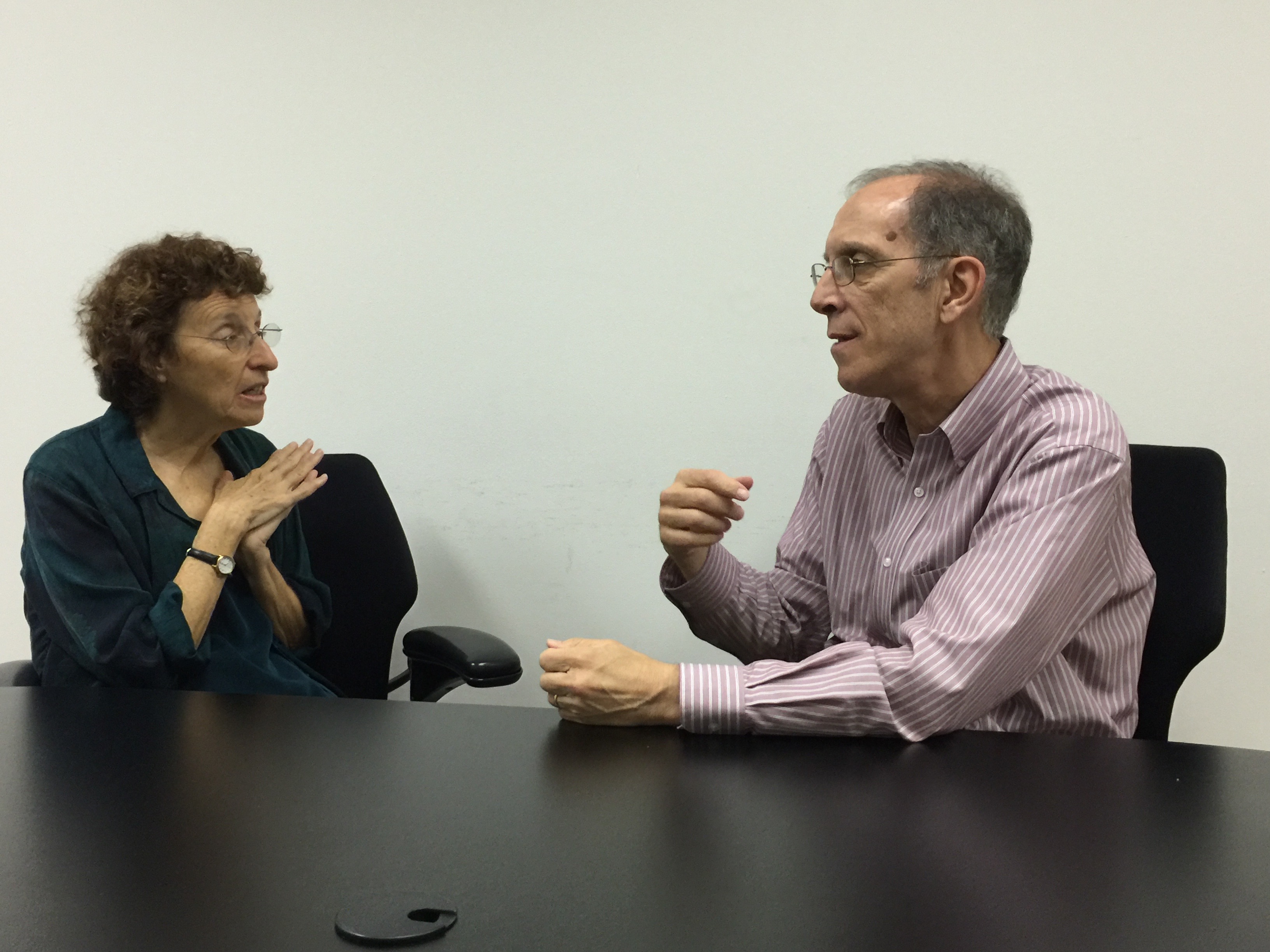 Ron and I were already champions of Dan Cohen’s world-changing Music & Memory program, which is featured in Connecting in the Land of Dementia, but we had never met Dan in person. The moment we learned we were going to New York City, we reached out to Dan and he agreed to meet with us.
Ron and I were already champions of Dan Cohen’s world-changing Music & Memory program, which is featured in Connecting in the Land of Dementia, but we had never met Dan in person. The moment we learned we were going to New York City, we reached out to Dan and he agreed to meet with us.
Dan is a prime example of one collaborative person making a difference for thousands. Eighteen states have already funded Music & Memory rollouts as a best practice approach for care facilities to improve quality of life for persons with dementia. In Toronto, everyone who is diagnosed with dementia receives a free iPod so they can enjoy personalized music. Dan and his team have trained 5000 dementia care managers, who understand how effective this program is. He is currently collaborating with hospitals, hospice, and prisons, as well as long term care communities.
Here is some of the wisdom he shared with us.
“We all need to create our personal play lists now,” Dan says. “Music makes any healthcare encounter better. Whether you’re waiting in the doctor’s office, going into the hospital, attending rehab, or moving into a care community, you’ll have a more comfortable experience when you are able to listen to favorite songs.”
Click here to listen to Dan Cohen.
Click here to learn more about the Music and Memory program.
Read more about Dan’s programs in Connecting in the Land of Dementia: Creative Activities to Explore Together. Order your copy from your favorite independent or online bookstore.
Three Benefits of Artistic Alchemy
Last week, I wrote about Julian West and his work with music and dementia. Hannah Zeilig, PhD, is an expert in culture, language, and dementia, who participated in and documented Julian’s program. When I interviewed Hannah, I was inspired by her perspective on arts and communications and wanted to share a few of her key ideas.
“The project showed us that you can converse in so many ways,” says Hannah. “The musicians and the dancer reminded us that we all can communicate without language.”
“One of the questions we’re asking in the UK is ‘How can the arts help with dementia? What can arts do that a game of dominoes cannot?’ ” Hannah says. “The arts help people become brave in how they connect with each other.”
The arts also transcend our dependence on achievement, identity, and memory.
“Being scared of dementia is the biggest barrier,” Hannah says. “In our language and our media, dementia is stigmatized and portrayed as catastrophic. One of the natural and common fears is summarized by this: ‘If I can’t remember where I live and my achievements, how do I know who I am?’
Julian’s work reminds us that we are all creative.
“People with dementia can be brimming with creativity and humor and able to make connections with each other,” Hannah says.
During one of Julian’s sessions, the musicians were playing and the dancer was cavorting around the circle. One resident, Alicia, walked right up, took the dancer’s hands and lead her in a waltz.
At the end of the dance, Alicia was glowing. She smiled and said, “We really just did something.”
And she was right.
….
Other gifts from this work in the arts:
- The residents communicated with more sounds and gestures.
- The staff saw the creative side of the residents.
- The creative atmosphere opened everyone up to alternate ways to connecting.
For more about Hannah and her work, visit:
